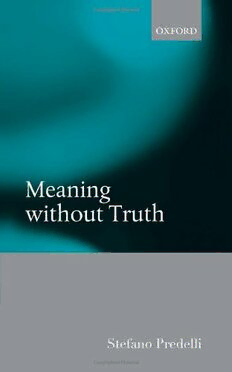
Meaning without Truth PDF
Preview Meaning without Truth
Meaning without Truth This page intentionally left blank Meaning without Truth Stefano Predelli 1 3 GreatClarendonStreet,Oxford,OX26DP, UnitedKingdom OxfordUniversityPressisadepartmentoftheUniversityofOxford. ItfurtherstheUniversity’sobjectiveofexcellenceinresearch,scholarship, andeducationbypublishingworldwide.Oxfordisaregisteredtrademarkof OxfordUniversityPressintheUKandincertainothercountries #StefanoPredelli2013 Themoralrightsoftheauthorhavebeenasserted FirstEditionpublishedin2013 Impression:1 Allrightsreserved.Nopartofthispublicationmaybereproduced,storedin aretrievalsystem,ortransmitted,inanyformorbyanymeans,withoutthe priorpermissioninwritingofOxfordUniversityPress,orasexpresslypermitted bylaw,bylicenceorundertermsagreedwiththeappropriatereprographics rightsorganization.Enquiriesconcerningreproductionoutsidethescopeofthe aboveshouldbesenttotheRightsDepartment,OxfordUniversityPress,atthe addressabove Youmustnotcirculatethisworkinanyotherform andyoumustimposethissameconditiononanyacquirer BritishLibraryCataloguinginPublicationData Dataavailable ISBN 978–0–19–969563–8 PrintedandboundinGreatBritainby CPIGroup(UK)Ltd,Croydon,CR04YY To David Kaplan This page intentionally left blank Preface ‘In the winter of 1995, as I was conducting my annual tour through the delightsofDemonstratives,Ipausedatafamiliarfootnote.Itstruckme,for thefirsttime,asintriguing.’Thusbeganmydissertation,writtenatUCLA under David Kaplan’s supervision. The footnote in question had to do withoperators on character,and provided the impetus for myinterest in lessthanstraightforwardusesofindexicalexpressions.Myruminationson recordingdevices,monsters,andotherescapesfromtheGeworfenheitofthe here-and-noweventuallyledmetoextendKaplan’sfootnoteintoawhole book,Contexts(Predelli2005a). Icannowrecyclemylittleinsiderjoke,adaptingittoanotherjuncture inDemonstratives(andAfterthoughts),thistimeacoupleofsentencesdealing with the very aims and scope of semantic theorizing.1 What struck me during my more recent annual tours, a few years ago, had to do with Kaplan’s distinction between verities and vagaries—a distinction I had alreadybeguntotackleinContexts,butwhichgrewuncontrollablyinits importancewithinmylucubrationsonlanguage.Aspartoneofthisbook indirectlytestifies,Iendedupconsideringtheobliterationofthatdistinc- tionastherootofallsemanticevils,aconfusion soperniciousandyetso temptingthatIdetecteditspresenceinprettymucheverythingIdisliked within my theoretical surroundings. With apocalyptic overtones, I now give that mistake an appropriately high-sounding moniker: the Fallacy of MisplacedCharacter,themainfocusofchapterthreeinthisbook. Yet, like the Hegelians, one sometimes loves a synthesis. Or, at least, onefalls inlovewiththelandscapeofthefrontier—inmycase,withthe calm and collected whisperings that lie between the loud vulgarity of de factousesandthedizzyingsilenceofdejurecharacters.Thewhisperings(in Kaplan’ssenseofthemetaphor)aretheprovinceofnontruth-conditional meaning:meaningallright,withalltheaccompanyingverities,butnotthe 1 Fortheoutsiders,thejokehastodowiththebeginningofKaplan’s‘Opacity’:‘In1978, as I was conducting my annual tour through the delights of [Quine’s] “Quantifiers and PropositionalAttitudes”,Ipausedatafamiliartransactionpoint.Itstruckme,forthefirst time,aspuzzling’(Kaplan1986:229). viii PREFACE sortofmeaningthat,likecharacter,endsuphavinganimpactonmatters of truth.2 Thus emerged my interest for ‘meanings without truth’—an interest that eventually led me to what I now call the Theory of Bias, presented and developed in parts two and three of this Meaning Without Truth. Agenotwithstanding,myHegelianleaningsnever(atleastwilfullyand consciously) embrace the lunacy of contradiction. Indeed, I have always understood my Theory of Bias not only as firmly consistent with my disdain for Misplaced Character, but as giving that fallacy even greater urgency:whatnowriskstobeimproperlyclassifiedamongtheveritiesof characterarenotonlythevagariousregularitiesofaction,butalsothevery differentveritiesofbias. Itwasnotsosurprising,then,thatKaplan’sshadowcontinuedtobecast over my first timid ventures beyond the truth-conditional borderline. In fact, it should have been utterly obvious from the beginning, since, already inthe nineties,Kaplanmanifested the first signs of hisfascination for‘ouch’and‘oops’,andforsomeofthephenomenaItackleinparttwo. ThereasonwhyIremainedlukewarmthen,andwhyittookmesolongto understand the considerable significance of non truth-conditional mean- ingforsemanticsatlarge,maywellhavehadtodowithKaplan’srhetoric at the time: to my horror, nothing less than a rejuvenated version of that infamous slogan, ‘meaning is use’. What an unwelcome intrusion of that Wittgensteinian anathema among the austere verities we aimed at unveiling,thoseWednesdayafternoons!3 Iamnotsosurenow.ButIhavetheimpressionthat,whenitcomestoa few aspects of the big picture, I am still not in complete agreement with Kaplan’s new approach to meaning at large. At least as far as slogans go, meaningisformestillmostdefinitelynotuse,inthesenseofuseIdiscussin partone.And,accordingtoparttwo,somekindofmeaning,namelybias, maywellhavetodowithuse(inaverydifferentsenseoftheterm‘use’), but is most definitely not all there is to meaning. Indeed, if I have 2 I am thinking here of Kaplan’s allusions to ‘whispered asides’, which I now (highly contentiously)regardasprecursorsofhisinterestforthenontruth-conditionaldimension(see Kaplan1989). 3 TheUCLAWorkshopinphilosophyoflanguage,whereIfirstheardKaplan’sideason ‘ouch’and‘oops’,usedtomeetinDoddHall,onWednesday,at3p.m. PREFACE ix preciouslylittletosayaboutcharacterinthisbook,thatispreciselybecause myventuresintobiasedterritoriesleavenotracewithintheincorruptible provinceoftruth-conditionalmeaning. Thatisnottosaythatcharacterandbiasfollowparallelpaths,andnever interact with each other in semantically interesting, and sometimes sur- prising ways. Indeed they do, as I explain in part three, where I discuss issuesinthevicinityofwhatIcallobstinacy,theeffectofbiason(indexical) character. It is here where I dare to boldly go where no semanticist has gone before. I start with allegedly ‘philosophically marginal’ phenomena such as vocatives, dates, and signatures, and I argue that their analysis provides the key to well-known topics of semantic befuddlement: pure quotation,theGiorgione-Barbarellipuzzle,thereflexiveuseoflanguage, the significance of demonstrations for demonstratives, and, more gener- ally,therelationshipsbetweenmeaningandcontext.WhatIendupwith are,toputitmildly,unexpectedresults—amongmyfavourites,theideaof context-insensitiveindexicals,andthedefenceofthesubstitutivityofco- referentialexpressionswithinquotationmarks.IfIweremistakeninanyof this,Iwouldnotbemistakeninthesenseofbeingsubtlyconfusedor,in that trite locution from the most inept philosophical rhetoric, of being ‘profoundlymistaken’.IfIwerewronginpartthree,Iwouldbewrongin the sense of being, obviously and superficially, off the wall. No worries: IherebyassertthatIamnotwrong. The main theme of this book is philosophical or ‘meta-semantic’: my discussion of the divide between vagaries and verities indirectly paints a certainpictureoftheaimsandscopeofdifferentareasoflinguisticenquiry, withparticularattentiontotheirrelationshipswithsemantics,inthesenses of ‘semantics’ relevant for my project. The reader interested in unveiling thegeneralpictureshouldreadthebookfrombeginningtoend,but,ifin a hurry, can afford to skip the starred sections and/or chapters. As I proceed towards the finished painting, I drop my pearls of wisdom regardingthisorthatlinguisticphenomenon,andthisorthatphilosophical problem (only very occasionally with the aim of presenting a complete theory or of defending a decisive solution). The reader interested in my views about the topics mentioned in the main chapter headings may perhaps jump straight to the relevant sections, but chapters four and
